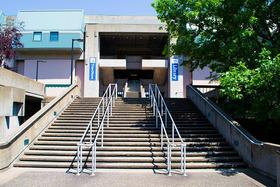School Highlights
Fortis College-Cincinnati serves 693 students (97% of students are full-time).
The college's student-teacher ratio of 15:1 is lower than the state community college average of 22:1.
Minority enrollment is 76% of the student body (majority Black), which is more than the state average of 38%.
Quick Facts (2025-26)
- Enrollment: 693 students
- Private-state tuition: $15,124
- Acceptance Rate: 65%
- Student-teacher ratio: 15:1
- Minority enrollment: 76%
- Source: Integrated Postsecondary Education Data System (IPEDS)
Top Rankings
Fortis College-Cincinnati ranks among the top 20% of public schools in Ohio for:
Category
Attribute
School Resources
School Overview
The teacher population of 47 teachers has stayed relatively flat over five years.
Fortis College-Cincinnati
(OH) Community College Avg.
Carnegie Classification
Special Focus Two-Year: Health Professions
Baccalaureate/Associate's Colleges: Mixed Baccalaureate/Associate's
Institution Level
At least 2 but less than 4 years
At least 2 but less than 4 years
Institution Control
Private for-profit
Private not-for-profit
Total Faculty
47 staff
93 staff
School Calendar
Student Body
The student population of Fortis College-Cincinnati has grown by 23% over five years.
The student-teacher ratio of 15:1 has increased from 12:1 over five years.
The Fortis College-Cincinnati diversity score of 0.54 is less than the state average of 0.58. The school's diversity has stayed relatively flat over five years.
Total Enrollment
693 students
757 students
Student-Teacher Ratio
15:1
22:1
# Full-Time Students
675 students
397 students
# Part-Time Students
18 students
360 students
# Enrollment Undergraduate
693 students
313 students
# Full-Time Undergraduate Students
675 students
385 students
# Full-Time Graduate Students
n/a
10 students
# Part-Time Undergraduate Students
18 students
434 students
# Part-Time Graduate Students
n/a
3 students
Total Dormitory Capacity
n/a
425 students
% American Indian/Alaskan
1%
n/a
% Asian
2%
4%
% Hispanic
3%
6%
% Black
63%
15%
% White
24%
62%
% Hawaiian
n/a
2%
% Two or more races
4%
4%
% Non Resident races
n/a
1%
% Unknown races
2%
6%
Diversity Score
0.54
0.58
College Completion Rate (Students who graduate in less than 4 years)
42%
54%
College Completion Rate (Students who graduate in 4 years or more than 4 years)
n/a
22%
Average Graduate Earnings (10 Years)
$27,700
$31,900
Tuition and Acceptance Rate
The private state tuition of $15,124 is more than the state average of $14,014. The private state tuition has stayed relatively flat over four years.
Private State Tuition Fees
$15,124
$14,014
% Students Receiving Some Financial Aid
98%
88%
Median Debt for Graduates
$12,139
$18,500
Median Debt for Dropouts
$5,500
$6,500
Acceptance Rate
65%
73%
SAT Reading
n/a
460
SAT Math
n/a
475
SAT Writing
n/a
465
ACT Composite
n/a
21
ACT English
n/a
20
ACT Math
n/a
20
Source: 2024 (or latest year available) Integrated Postsecondary Education Data System (IPEDS) , School Administrators
Frequently Asked Questions
How much does Fortis College-Cincinnati cost?
Fortis College-Cincinnati's private state tuition is approximately $15,124.
What schools are Fortis College-Cincinnati often compared to?
Fortis College-Cincinnatiis often viewed alongside schools like ATA College-Cincinnati by visitors of our site.
What is the acceptance rate of Fortis College-Cincinnati?
The acceptance rate of Fortis College-Cincinnati is 65%, which is lower than the state average of 73%.
What is Fortis College-Cincinnati's ranking?
Fortis College-Cincinnati ranks among the top 20% of community college in Ohio for: Percent of students receiving financial aid.
Recent Articles

How to Transfer from Community College to a Four-Year University in 2025
A step-by-step guide for community college students transferring to a four-year university in 2025 — updated strategies, data and expert insights.

Scholarships for Community College Students 2025
Explore updated scholarship programs, tuition data, and expert strategies for community college students in 2025.

The Rise of Technical and Vocational Training in 2025
Explore the 2025 surge in technical and vocational training—enrollment, policy, costs, and why this path is gaining ground for students and parents.








